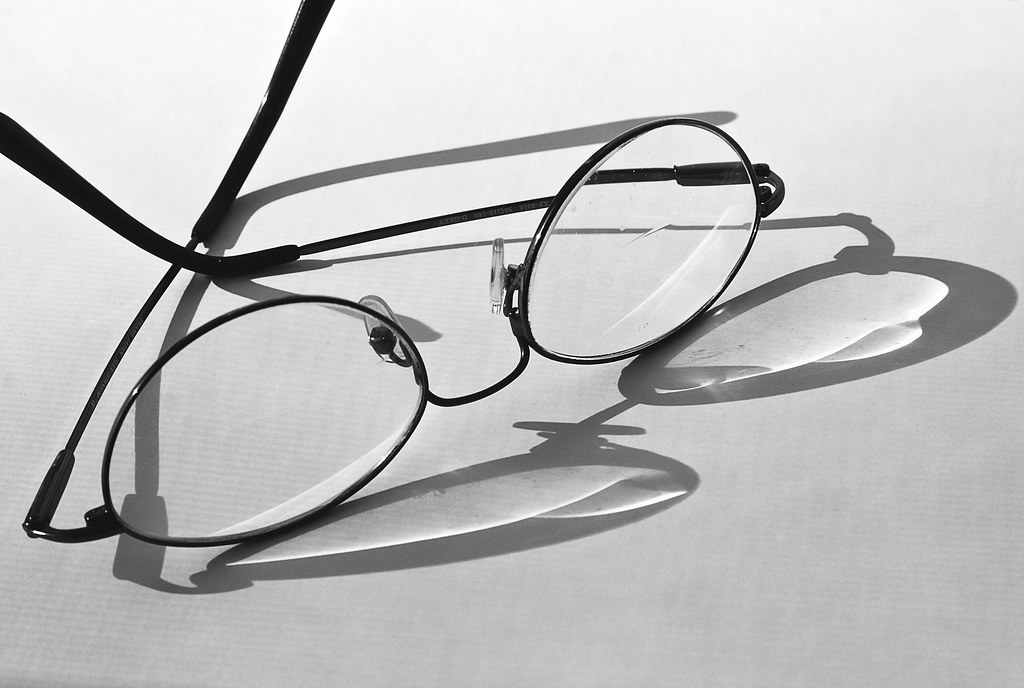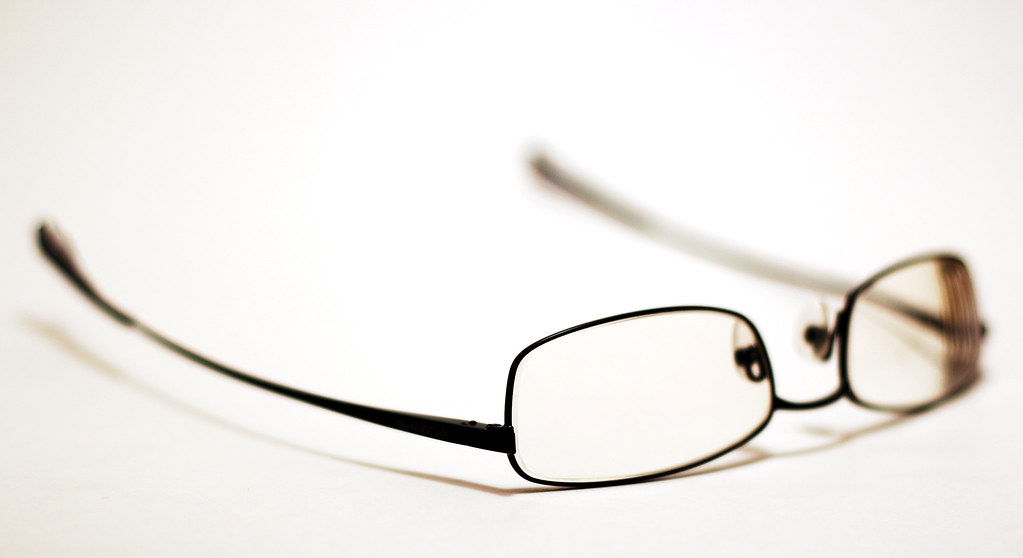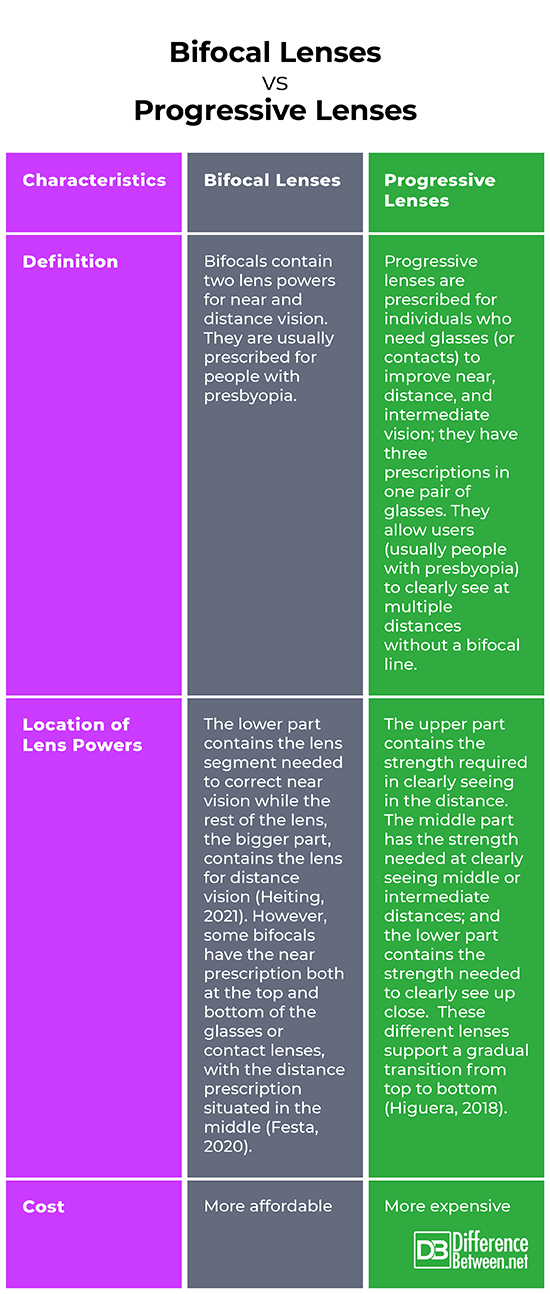Difference Between Bifocal Lenses and Progressive Lenses
Both bifocal and progressive lenses are multifocal (contain at least two lens powers) eyeglass lenses often prescribed for people over age 40 who have presbyopia. They may also be sometimes prescribed for young adults or children. Specifically, bifocals contain two lens powers while progressive lenses have three prescriptions in one pair of glasses. The following discussions further delve into their differences.

What are Bifocal Lenses?
As its name suggests, bifocals contain two lens powers. Usually, the lower part contains the lens segment needed to correct near vision while the rest of the lens, the bigger part, contains the lens for distance vision. Usually, people who use bifocals look up and through the distance portion when they need to focus on far objects while they look down through the lower part of the lens when they need to focus on near objects, generally, within 18 inches (Heiting, 2021). However, some bifocals have the near prescription both at the top and bottom of the glasses or contact lenses, with the distance prescription situated in the middle. These modern bifocals are ideal for people who often need to look up at near objects such as electricians and librarians (Festa, 2020). Bifocals are often prescribed for people over age 40 who have presbyopia, a gradual loss of the ability to focus on nearby objects (usually a part of aging). They may also be used by children and young adults who have eye strain from focusing problems or eye teaming (Heiting, 2021).
The following are the different kinds of shapes of lens segments, also called “seg”, which are used for near-vision correction:
- Round segment (tend to be less noticeable)
- Half -moon, straight-top, flat-top, or D-segment
- Ribbon segment (narrow rectangular area)
- Franklin, Executive, or E style (full bottom half of lens)
The following outlines the uses of bifocal lenses (Helting, 2021):
- Bifocals often have wider lens areas ideal for computer work and reading.
- These lenses are sometimes prescribed for children and young adults who suffer from eye strain due to focusing problems (i.e., reading). The bottom part lessens the effort required in clearly seeing near objects.
- Studies suggest that wearing bifocal lenses may be helpful in controlling the myopia of some children.

What are Progressive Lenses?
Progressive lenses are prescribed for individuals who need glasses (or contacts) to improve near, distance, and intermediate vision; they have three prescriptions in one pair of glasses. They allow users to clearly see at multiple distances without a bifocal line. They are described as an update on trifocal and bifocal lenses as they have a seamless look; they invisibly blend the focal areas and can provide clear vision even in the spaces in between the prescription strengths (Festa, 2020).
A progressive lens’ upper part contains the strength required in clearly seeing in the distance. The middle part has the strength needed at clearly seeing middle or intermediate distances; and the lower part contains the strength needed to clearly see up close. The aforementioned lenses support a gradual transition from top to bottom (Higuera, 2018). However, it may be difficult for some people (as many as 10%) to adapt to wearing progressive lenses since it is more devoted to blending than having specific focal areas (Festa, 2020). Other drawbacks include experiencing visual distortions and higher costs (Higuera, 2018).
Progressive lenses are typically needed by individuals over the age of 40 who have farsightedness or presbyopia which is characterized by having blurry vision when focusing on closeup or near objects and activities. They may also be prescribed for children to prevent the worsening of nearsightedness or myopia (Seltman, 2020).
The following outlines the benefits of progressive lenses:
- Progressive lenses allow users to see clearly at different distances.
- They offer multifocal lens benefits without a multifocal line and without sudden changes in clarity.
- They give a more modern and youthful appearance since there is no visible line.
Difference between Bifocal Lenses and Progressive Lenses
Definition
As its name suggests, bifocals contain two lens powers for near and distance vision. They are usually prescribed for people with presbyopia. On the other hand, progressive lenses are prescribed for individuals who need glasses (or contacts) to improve near, distance, and intermediate vision; they have three prescriptions in one pair of glasses. They allow users (usually people over age 40 who have presbyopia) to clearly see at multiple distances without a bifocal line (Festa, 2020).
Location of Lens Powers
Regarding bifocals, the lower part contains the lens segment needed to correct near vision while the rest of the lens, the bigger part, contains the lens for distance vision (Heiting, 2021). However, some bifocals have the near prescription both at the top and bottom of the glasses or contact lenses, with the distance prescription situated in the middle. These modern bifocals are ideal for people who often need to look up at near objects such as electricians and librarians (Festa, 2020). In comparison, a progressive lens’ upper part contains the strength required in clearly seeing in the distance. The middle part has the strength needed at clearly seeing middle or intermediate distances; and the lower part contains the strength needed to clearly see up close. These different lenses support a gradual transition from top to bottom (Higuera, 2018).
Cost
Bifocals are generally more affordable as compared to progressive lenses.

Summary
- Both bifocals and progressive lenses are usually prescribed for people with presbyopia.
- Bifocals contain two lens powers for near and distance vision.
- Progressive lenses are prescribed for individuals who need glasses (or contacts) to improve near, distance, and intermediate vision; they have three prescriptions in one pair of glasses.
- Difference Between Hematoma and Melanoma - February 9, 2023
- Difference Between Bruising and Necrosis - February 8, 2023
- Difference Between Brain Hematoma and Brain Hemorrhage - February 8, 2023
Search DifferenceBetween.net :
Leave a Response
References :
[0]Festa, A. (2020). The difference between bifocals and progressive lenses. Healthgrades. https://www.healthgrades.com/right-care/eye-health/the-difference-between-bifocals-and-progressive-lenses
[1]Heiting, G. (2021). Bifocals and trifocals: Solutions for “short arms”. All About Vision. https://www.allaboutvision.com/lenses/multifocal.htm
[2]Higuera, V. (2018). What are progressive lenses and are they right for you? Healthline. https://www.healthline.com/health/what-are-progressive-lenses
[3]Seltman, W. (2020). Are progressive lenses right for you? WebMD. https://www.webmd.com/eye-health/about-progressive-lenses#:~:text=Progressive%20lenses%20have%20three%20prescriptions,re%20sometimes%20called%20multifocal%20lenses.
[4]Image credit: https://live.staticflickr.com/2125/2046033676_ab6788b2c6_b.jpg
[5]Image credit: https://live.staticflickr.com/5220/5451626336_0da7223172_b.jpg
